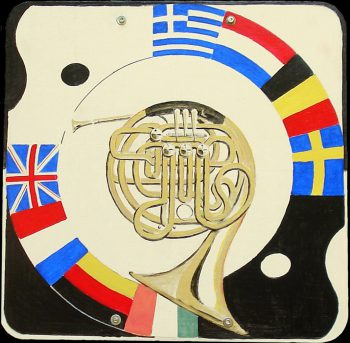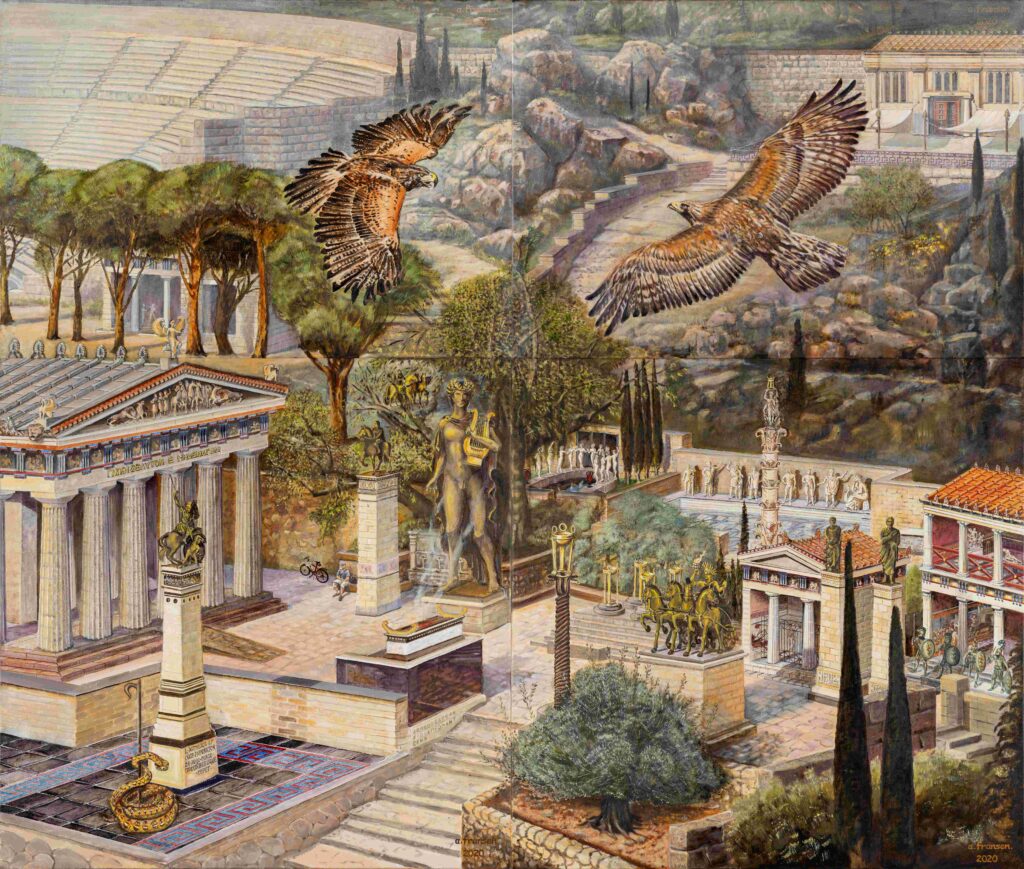ὕβρις | Hubris
Four parts
oil on canvas (cotton)
170 × 200 cm
December 2020
Design after the model of Nicos Andricakis, published in Delphes by Ekdotike Athenon S.A. 1980.
This is an impression of the sanctuary of Apollo, ancient Delphi, from the perspective of the eagle. According to myth, Zeus sent two eagles to find the centre of the world, which turned out to be Delphi. This place existed as a sanctuary for more than a thousand years; now, sixteen centuries later, only ruins remain.
The old world-view with fate-foretelling and other governing gods has been dissolved in history. A new idea arose; man with his gigantic achievements became the ruler of nature and the future, instead of a god. This now appears to be equally incorrect, however beautiful he and she may be in God’s image, or vice versa.
How promising are those essential achievements to survive unhinged and strangling viruses of a different nature?
Reminiscences:
- Martin Phipps: Aberfan disaster music from The Crown
- Gustav Mahler / Friedrich Nietzsche: Symphony 3, part 4: ‘What Man Tells Me’
- Metallica’s song Nothing else matters
» Read more
It is thought that society started changing some ten thousand years ago. Manipulation of plants and animals gradually allowed mankind to live in a more confined area with farmed crops and animals . . . at least as long as climate, weather and all kinds of other conditions remained favourable. The already existing idea that there was a will behind those circumstances led to their personification. It was known for thousands of years that the gods could be consulted and influenced in exchange for sacrifices, often with burnt offerings. The shepherd’s staff and the olive tree as well as Sitalcas (wheat), the name of the 16 m tall statue of Apollo according to the Delphians, symbolize this worldview here.
The snake plays a prominent but dual role. The Delphic python represents a monster, the dark side of our being and existence, conquered by Apollo, bringer of light, insight and beauty. Apollo was the mythical god of the muse, but also of medicine, he was the father of Asklepios.
Up to our time, the esculap (the symbol of Asklepios) stands for healing, because a snake can shed its skin, which means rebirth or healing, but it can also bring death through its bite.
I have opted for a very large constrictor, the reticulated python, not for a venomous snake. The symbolic wrapped staff is a shepherd’s staff.
The eagle, with its mighty wing-beat, is – or was believed to be – the highest flying of all living creatures and therefore closest to the sun, having the best overview of the earth. This explains its mythical significance over time.
The Aquilifer (lit. eagle-bearer) was part of the first cohort of the Roman legions, the most important field sign, sign of power (overview = knowledge = power). In a biblical context, the eagle is an attribute of the evangelist John. This has to do with the high philosophical flight that this evangelist takes to pass on his message. In his version of the New Testament he refers to the apocalypse (Ancient Greek: ἀποκάλυψις, apokálypsis, ‘a revelation’)
» Read less

